Introduction
Potato is the 4th the major food crops after rice, wheat, and maize. It receives the special preference for consumption mainly because of potato’s richness in carbohydrates and necessary micronutrients that can cater total energy supply to the human body.1 Potatoes contain high levels of nutrition such as carbohydrate, fibers, Vitamin C, folic acid, vitamins (B1, B3, B6), minerals like potassium, iron, zinc, and phenolics compounds.2-4 Continuous efforts have been delivered by potato breeding program throughout the world to develop new potato cultivars with enhanced phytonutrients.5 Colored potato tubers with distinctive flesh and skin color such as red, purple, yellow are highly rich in antioxidants.6
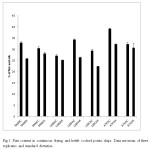 |
Figure 1: Fats content in continuous frying and kettle cooked potato chips. Data are mean of three replicates and standard deviation Click here to View figure |
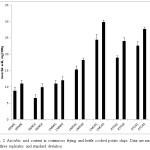 |
Figure 2: Ascorbic acid content in continuous frying and kettle cooked potato chips. Data are mean of three replicates and standard deviation Click here to View figure |
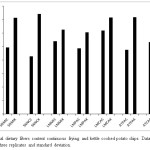 |
Figure 3: Total dietary fibers content continuous frying and kettle cooked potato chips. Data are mean of three replicates and standard deviation Click here to View figure |
There is a significant variation in nutritional composition among potato cultivars due to genetic, physiological and environmental effects.7 Growing environment mainly related to an elevation above sea strongly influences the level of metabolites. Certain metabolites keep changing within the growing season of the potato plants, for example, matured potato tubers accumulate the lower quantity of reducing sugars than the immature and young tubers. Preharvest conditions, for instance, soil composition, fertilizer input and climate, as well as postharvest storage conditions, play a major role in the differences and changes of potato metabolites i.e. Vitamin C, polyphenols, alkaloids and reducing sugars in tubers.7-11
Potatoes are always cooked before consumption and cooking methods change the composition of the potato matrices.12 While some of the existing nutrient content are reduced or enhanced, some newer nutrient/anti-nutrient compound are formed during cooking.13 Earlier publications from our laboratory reported that cooking influence the content of these micronutrients in potato tubers where levels of vitamins, minerals, polyphenols, carotenoids and fiber reduced after cooking by a different method such as boiling, baking, microwaving and frying.6,14 There is a high potential for the formation of Maillard Reaction Products (MRP) when potatoes are cooked at a temperature >120 ºC due to the presence of its precursors such as free amino acid and reducing sugars. Some of the MRP act as an antioxidant and hence might contribute towards the antioxidant capacity of the whole products.15 However, some MRP such as acrylamide is also formed in fried potato products via the reaction of asparagine and reducing sugars.16
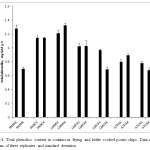 |
Figure 4: Total phenolics content in continuous frying and kettle cooked potato chips. Data are mean of three replicates and standard deviation Click here to View figure |
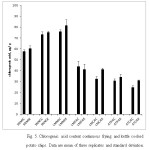 |
Figure 5: Chlorogenic acid content continuous frying and kettle cookedpotato chips. Data are mean of three replicates and standard deviation Click here to View figure |
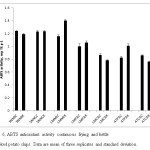 |
Figure 6: ABTS antioxidant activity continuous frying and kettle cooked potato chips. Data are mean of three replicates and standard deviation Click here to View figure |
Based on recipe and cooking traditions potatoes are consumed in the various forms like mashed potato, potato cubes, potato chips and French fries. However, potato chips are the most popular and widely consumed by all ages and even on a full stomach, due to the high ratio of fats and carbohydrates, which send a pleasing message to the brain.17 From the consumers’ standpoint potato chips are related to its unique sensory characteristics, including flavor, texture, and appearance. Nutritional content of all types of potato chips is not same due to differences in the composition of raw materials and cooking methods. The aim of this study was to determine the nutritional composition of potato chips made from three potato cultivars grown in four different states in the USA and processed by two separate methods viz. continuous frying and kettle cooked.
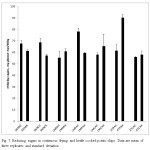 |
Figure 7: Reducing sugars in continuous frying and kettle cooked potato chips. Data are mean of three replicates and standard deviation Click here to View figure |
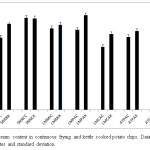 |
Figure 8: Potassium content in continuous frying and kettle cooked potato chips. Data are mean of three replicates and standard deviation Click here to View figure |
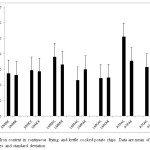 |
Figure 9: Iron content in continuous frying and kettle cooked potato chips. Data are mean of three replicates and standard deviation Click here to View figure |
Materials and Methods
The selected potato cultivars used in the study are shown in Table 1. The potato chips were provided by the processors. After receiving the potato tubers from suppliers, we washed and peeled about 0.2 mm thick from each tuber. Each potato tubers were cut into small pieces and grouped into two sets. One set was used to analyze few nutrients as fresh weight (FW), and another set was freeze dried to analyze the nutrient content as dry weight basis (DW). Similarly, potato chips were also ground by using mortar and pestle after receiving. Nutritional analysis of potato chips was performed using methanolic-hexane extraction. The methanolic extract of freeze or fresh powders were used for the analysis of sugars, phenolics, antioxidant activity, chlorogenic acid, dietary fibers, minerals, vitamin C, and glycoalkaloids. Total sugars were analyzed by the di-nitrosalicylic method as described.16 D+ glucose was used as a standard for quantification. Phenolics content were estimated by using a Folin-Ciocalteo method using galleic acid as standard. Vitamin C was estimated following the method in AOAC’s titrimetric methods where metaphosphoric acid (MPA)-acetic acid extracts of fresh potato tubers were titrated with indophenol solution.18 Total dietary fiber (TDF) content was determined according to the Association of Analytical Chemists (AOAC) method using the reagent kit K-TDFR from Megazyme (Megazyme Int, Ireland, Wicklow, Ireland). 2,2′-azino-bis (3-ethylbenzothiazoline-6-sulphonic acid) (ABTS) antioxidant assay was tested for the antioxidant properties.6, 19 Glycoalkaloids were estimated as described by Bostock et.al.,20 Acrylamide was estimated by Gas Chromatography and mass spectrometer method as described.16
Statistical analysis
All experiments were carried out in triplicated, and the statistical analysis were performed by one-way analysis of variance (ANOVA) at p ≤ 0.05 significance level. Error bars in figures are based on calculated Fisher’s LSD at α = 0.05 using the standard error for LS means and approximated at T-value of 2.
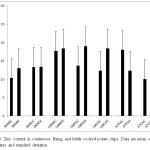 |
Figure 10: Zinc content in continuous frying and kettle cooked potato chips. Data are mean of three replicates and standard deviation Click here to View figure |
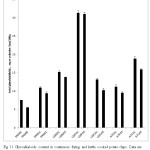 |
Figure 11. Glycoalkaloids content in continuous frying and kettle cooked potato chips. Data are mean of three replicates and standard deviation Click here to View figure |
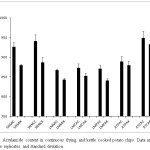 |
Figure 12: Acrylamide content in continuous frying and kettle cooked potato chips. Data are mean of three replicates and standard deviation Click here to View figure |
Results and Discussion
Fats and carbohydrate
Fats and carbohydrate are key components of many snack foods which determines its palatability. A limited amount of fat is necessary to the sensory properties of foods because it can carry fat-soluble flavors, enhance viscosity and provide lubrication in the mouth. The ratio of fats and carbohydrate determines the palatability of snack food. The average amount of fats in the continuous chips was 32.2% with a range of 27.12 – 39.11 while in the kettle chips was 27.20% with a range 22.37 – 32.22 (Fig. 1). Thus, there are a 5% fewer fat in kettle chips than the continuous chips. Among the continuous chips, ATPAC had higher fat content whereas LMMIC had the lowest. Significant differences were evident (P ≤ 0.05) among the potato chips made of 7 different cultivars. Moreover, there were noteworthy differences among chips as compared with growing locations and processing methods, for example, there are significant difference a) between SNMIC and SNNCC, b) among LMMIC, LMPAC, and LMCAC, and c) between ATPAC and ATCAC.
Potato chips have oil content that ranges 30-45% and gives the product unique and desirable texture-flavor combination. Consequently, it is becoming one of the most popular snacks for all consumers including kids. However, there is an urgent recommendation by the U.S. Food and Drug Administration to reduce fats in fried potato food products. Many strategies to reduce fat content are being adopted, for instance, vacuum frying, continuous frying, and kettle cooked.21 From our results, we observe that kettle cooked chips absorb less oil than the continuous frying chips. This difference in uptake of oil arises due to the size and surface-to-volume ratio of the potato slices used for frying. Choe et.al., reported that during frying oil and fats result in the formation of many the new compound through thermal, oxidative and hydrolytic reactions.22 Aniolowska et.al., reported that raw materials and the water change the thermo-oxidative stability of oils during frying of chips.23 These changes might have a critical role in other health beneficial effect like antioxidant activities.
Table 1: Potato cultivars and chips (First two letters stand for variety, third and fourth letter stands for location (State, USA), the fifth letter stands for processing method, C: continuous; K: Kettle)
|
Cultivars |
Locations(States: MI, NC, PA, and CA) | Frying method | |
| Continuous | Kettle | ||
|
1. Snowden SN |
SNMI | SNMIC |
SNMIK |
|
2. Snowden SN |
SNNC | SNNCC |
SNNCK |
|
3. Lamoka LM |
LMMI | LMMIC |
LMMIK |
|
4. Lamoka LM |
LMPA | LMPAC |
LMPAK |
|
5. Lamoka LM |
LMC | LMCAC |
LMCAK |
|
6. Atlantic AT |
ATPA |
ATPAC |
ATPAK |
| 7. Atlantic AT | ATCA | ATCAC |
ATCAK |
Table 2: Nutritional composition of selected potato tubers. Data are mean of three replicates and standard deviation
| Nutrient | SNMI | SNNC | LMMI | LMPA | LMCA | ATPA | ATCA |
| Vitamin C, mg/100g, FW | 12.35 ± 0.62 | 14.17 ± 1.09 | 15.62 ± 0.62 | 21.07 ± 0.62 | 36.69 ±0.62 | 29.43 ±1.66 | 33.79 ± 1.08 |
| Total dieatry fiber, % FW | 2.18 | 1.75 | 2.22 | 2.2 | 2.59 | 1.89 | 2.17 |
| Total phenolics, mg GAE/g, DW | 0.445±0.01 | 0.784±0.04 | 0.692±0.05 | 0.738±0.16 | 0.509±0.03 | 0.446±0.01 | 0.537±0.03 |
| Chlorogenic acid, µg/g, DW | 141.583±2.20 | 103.25±2.88 | 123.527±2.67 | 74.083±2.88 | 61.305±6.36 | 69.361±5.54 | 41.861±1.92 |
| Antioxidant activity, mg TE/g, DW | 0.939±0.04 | 1.012±0.01 | 0.961±0.02 | 0.870±0.03 | 0.812±0.02 | 0.582±0.03 | 0.790±0.03 |
| Total reducing sugars, mg/100g, DW | 317.2±20.0 | 121.2±10.5 | 92.866±3.2 | 144.866±5.9 | 186.866±5.9 | 2142.2±79.0 | 2305.2±88.0 |
| Potassium, % DW | 2.246±0.15 | 2.05±0.03 | 2.186±0.15 | 2.176±0.13 | 1.883±0.03 | 2.08±0.06 | 2.22±0.01 |
| Iron, mg/kg DW | 54±1.73 | 56.666±13.07 | 48.666±1.52 | 61±10.44 | 35.333±5.19 | 43±13.52 | |
| Zinc, mg/kg, DW | 17.333±0.57 | 18.333±0.57 | 221.333±0.57 | 23.333±1.52 | 22.666±2.3 | 21.666±1.52 | 10.00±0 |
| Glycoalkaloids, mg/100g, FW | 4.754±0.18 | 6.102±0.62 | 11.477±0.69 | 23.893±0.43 | 7.435±0.44 | 5.935±0.21 | 13.206±0.65 |
Reducing sugars
The major carbohydrates found in potato tubers are glucose, fructose, and sucrose. As preharvest, as well as postharvest conditions, control the amounts of the reducing sugars in potato tubers, and their levels vary in the tubers stored for processing.24,25 The average amount of reducing sugars for the potato tubers in our study was 5.1 mg/g DW. SNMI had the highest amount of reducing sugars (11.7 mg/g), whereas LMMI had the lowest (1.35 mg/g) amount (Table 1). There were significant differences (P ≤ 0.05) among few potato cultivars (Fig. 2). There were no significant differences among potato chips made of 7 different cultivars. The comparatively higher level of reducing sugars was observed for ATPA and ATCA which might be due to the shipping delay from the growing farm (data not shown). Numerous reports are available on the sugar content of potato tubers with great variations among the potato cultivars.26, 27 Although storing at a low temperature helps towards the inhibition of sprouts in potato tubers, but it leads to the accumulation of sugars by the process called cold-induced sweetening. To avoid the increase in sugar content potato tubers are stored between 8-12 ºC. The higher levels of reducing sugars in ATPA and ATCA varieties might be due to improper storage after harvesting and shipping (the data not shown in the table). The levels of reducing sugars went down in the potato chips as reducing sugars converted to various MRP’s during Maillard reaction. Acrylamide is one of the major MRP’s found in potato chips which is formed from the reaction of asparagine and reducing sugars.
Vitamin C
Vitamin C is necessary for normal connective tissue structure and function contributes cell protection from free radical damages and also contributes to better iron absorption in humans. The recommended levels of Vitamin C consumption according to National Institute of Health is 90 -120 mg per day for a healthy adult. Fresh potatoes are known to have up to 460 mg ascorbic acid per kg depending on the preharvest and postharvest conditions. In addition to the variations in cultivars, Vitamin C concentrations also vary as a function of the geographic region in which they are grown. The average amount of Vitamin C in the potato tubers was 23.30 mg/100g with a range 12.35 – 36.69 (Table 1). The highest Vitamin C content was in the LMCA while SNMI had the lowest level of Vitamin C. Significant differences were evident (P ≤ 0.05) among the different cultivars grown. Moreover, significant differences among cultivars were also observed as compared with growing locations. For example, there is a significant difference between SNMI and SNNC, among LMMI, LMPA, and LMCA, and between ATPA and ATCA. The average Vitamin C in continuous frying chips was 15.31 mg/100g with a range of 6.54 (SNNCC) – 24.34 (LMCAC) and the average vitamin C in the kettle cooked chips was 18.89 with a range 9.81 (SNNCK) – 29.79 (LMCAK) (Fig. 3). Significant differences were evident (P ≤ 0.05) among the potato chips made of 7 different cultivars. Also, there were noteworthy differences among potato chips as compared with growing locations a) among LMMIC, LMCAC, and LMPAC, b) between SNMIC and SNNCC, and c) ATPAC and ATCAC. Similar results were observed for a) among LMMIK, LMCAK, and LMPAK, b) between SNMIK and SNNCK, and c) ATPAK and ATCAK. There was a significant difference between the continuous frying and kettle cooked in each pair. Kulen et.al., reported the levels of Vitamin C levels in some potato cultivars where it levels falls within the similar range of our studies.11 Several studies showed that cooking and storage condition result in substantial loss of Vitamin C.13 Accordingly, in the potato chips as shown in the Fig. 2 we see there was a significant loss of Vitamin C in the potato chips. However, in the case of the kettle cooked potato chips, there was a lesser loss of Vitamin C compared to continuous frying.
Dietary fibers
Potatoes are found to have a good source of dietary fibers. Dietary fibers intake is linked to a lower risk of coronary heart disease and improvement in digestive health. Although various analytical methods applied for TDF measurements, each method considers the specific fractions of fibers of interest. For example, nonstarch polysaccharides procedure excludes lignin while the AOAC enzymatic-gravimetric methods fail to distinguish among the categories of polysaccharides, including resistant starch. In our study, enzymatic-gravimetric AOAC method was employed to measure total dietary fibers. The fiber levels in potato tubers were ranged from 1.75% to 2.59% with the average value of 2.14% (Fig. 4). SNNC had lowest, and LMCA had the highest level of dietary fibers among the potato tubers. The average TDF in continuous chips was 2.5% with a range 2.14 (SNNC) to 3.09 (LMCAC) and 3.39 % in kettle chips with a range 3.02 (LMPAK) to 3.71 (SNNCK). Mullin and Smith et.al., reported that 2 % TDF in raw potatoes and the levels of TDF were increased after baking of the tubers.28 They found a higher level of soluble dietary fibers than the insoluble fibers. Moreover, the flesh had a higher level of TDF than the skin. During cooking of starchy food, it can make the starch resistant to enzymatic degradation and thus form resistant starch. The higher fiber values may be due to the formation of these resistant starch. Storage, cultivar or growing conditions might affect the dietary fiber in potatoes. However, there were no significant variations among the cultivars gown at a different location across the United States.
Polyphenols and Antioxidant Activity
Potatoes are good sources of polyphenols such as phenolic acid, flavonoids, and anthocyanins.29 Flavonoids and anthocyanins are highly abundant on colored flesh potato tubers. Among phenolic acid, chlorogenic acid and its derivative are the most dominant soluble phenolic acid (about 80% of the total phenolic acid).4 Moreover, three isomers of chlorogenic acid i.e. neo-chlorogenic acid, crypto-chlorogenic, and chlorogenic acid are available. In our study, we measured the total phenolics and amount of chlorogenic acid in the potato tubers and potato chips using spectrophotometric methods. The levels of total phenolics in potato tubers were ranged from 0.44 to 0.78 with average level 0.591 mg g-1. The ATPA had lowest TP while SNNC had highest TP among the potato tubers. Significant differences were evident (P ≤ 0.05) among the seven potato cultivars. Moreover, significant differences among cultivars were also observed as compared with growing locations, for example between SNMI and SNNC, among LMMI, LMPA, and LMCA, and between ATPA and ATCA. The average total phenolics in continuous chips were 1.02 (with a range 0.77 (ATCAC) – 1.27 (SNMIC) and 0.92 (range 0.67 (SNMIK) – 1.32 (LMMIK)) in kettle chips. There were significant differences (p ≤ 0.05) among potato chips as compared with growing locations, for example, a) among LMMIC, LMCAC, and LMPAC, b) between SNMIC and SNNCC, and c) ATPAC and ATCAC. Similar results were observed for a) among LMMIK, LMCAK, and LMPAK, b) between SNMIK and SNNCK, and c) ATPAK and ATCAK. Interestingly there were significant differences (p ≤ 0.05) between the continuous frying and kettle cooked except a) between SNNCC and SNNCK and b) between LMPAC and LMPAK. The average level of chlorogenic acid in potato tubers was 87.85 µg/g with a range 41.86 -141.58. The SNMI had the highest level of chlorogenic acid while ATCA had the lowest level. The average levels of chlorogenic acid in continuous chips were 48.34 (range 24.63 (ATCAC) -75.75 (LMMIC)) and 52.01 in kettle chips (range 31.02 (ATCAK) -81.58 (ATPAK). The average ABTS antioxidant activity was 0.852 mg TE g-1 in the potato tubers with a range 0.75 TE g-1 to 1.01 TE g-1 with SNNC having the highest level and ATPA having the lowest antioxidant activity. The levels in chips are 0.82 (ATPAC) – 1.23 (SNMIC) and 0.77 (LMCAK) – 1.39 (LMMIK) continuous frying and kettle cooked respectively. Significant differences (P ≤ 0.05) were evident among the potato chips made of 7 different cultivars. Numerous reports are available on the studies of total phenolics in potato tubers. In our laboratory, we have been tested the levels of total phenolics in a different number of potato cultivars and advanced selections grown in Colorado. However, it was found that colored potato tubers have higher levels of total phenolic than the white and yellow ones. The range of TP in white potato tubers was 523 µg/g to 681 µg /g. Significantly red cultivars had the 1153 µg/g. Similar studies were made by Navarre et.al., containing a similar range of total phenolic and antioxidant activity.30 Due to the high levels of total phenolics, the potato chips had significant antioxidant activities which help to exhibit scavenging free radical that could damage DNA, RNA, and proteins and thus prevent from some pathological conditions. In our studies, we adopted the ABTS radical assay since ABTS radicals are more reactive than 1,1-Diphenyl-2-picryl-hydrazyl (DPPH), a commonly used free radical assay. ABTS assay is based on the reduction of the blue-green ABTS radical by the hydrogen donating antioxidants, and the absorption at 600 nm monitors the decay of the ABTS radical. The higher antioxidant activities arose from the presence of additional antioxidants in oils used in the frying since oils are composed of various phenolic compounds like gallic acid, cinnamic acid, vanillic acid, chlorogenic acid, p-coumaric acid, sinapic acid.31, 32 A strong correlation was observed between the total phenolics and antioxidant activities.
Minerals
Potato plants acquire mineral elements primarily from the soil solution through their roots. Minerals like potassium, iron, and zinc were reported to highly available in tubers.33 The average level of potassium in potato tubers were 2.12 % (range 1.88 (LMCA) – 2.24 (SNMI). The average levels in continuous chips are 1.34 % with range 1.10 (LMCAC) -1.61 (SNNCC) and in kettle chips are 1.47 % with the range 1.32 (LMCAK) -1.65 (SNMIK). The average levels of zinc in potato tubers was 19.23 mg/kg with a range 10.0 (ATCA) – 23.33 (LMPA). Continuous chips and kettle chips had 13.66 mg/kg (range 10 -18) and 14.90 mg/kg (range 10- 19) respectively. The average levels of iron in potato tubers, continuous chips, and kettle chips were 49.66 mg/kg (range 35.33 -61), 32.04 mg/kg (23 – 51) and 29.90 mg/kg (24.66 – 35.33) respectively. The results of minerals levels in the selected potato tubers varies among different cultivars with no significant correlations with the locations. Various factors including genotype, soil composition, weather, irrigation, and fertilization affect the levels of minerals in potato tubers. There was a significant loss of minerals after processing the potato chips in each of potato varieties due to leaching of the elements during cooking.
Glycoalkaloid
There are USDA limits on maximum amounts of glycoalkaloids in potato tubers as they have a toxic effect on humans and animals. The upper limit is to be approximately 200 mg/kg FW and 1 mg/g (100 mg/100 g) for DW.34 The concentration of glycoalkaloids in tubers depends on a number of factors, such as cultivar, maturity, and environmental factors. The intensity and nature of light and other stresses influence the level and formation of glycoalkaloids in tubers. Glycoalkaloids are relatively stable in potatoes and levels are not affected by boiling, freeze-drying, or dehydration. Microwave cooking has only a limited effect. The average glycoalkaloids in the potato tubers were 10.56 mg/100 g (range 4.75 – 23.89). LMPA had the highest level of glycoalkaloids whereas SNMI had the lowest of glycoalkaloids. The average glycoalkaloids in continuous frying chips were 15.42 (range 7.5 (SNMIC) – 31.2 (LMPAC) and in kettle chips 13.61 (range 5.51 (SNMIK)- 30.95 (LMPAK). Significant differences were evident (P ≤ 0.05) among the potato chips made of 7 different cultivars. Moreover, differences among cultivars were also observed as compared with growing locations. For example, there are a significant difference between SNMI and SNNC, among LMMI, LMPA, and LMCA, and between ATPA and ATCA. Several reports are available describing the levels of glycoalkaloids in potato tubers including the effect of cooking on it. The variation in glycoalkaloids in boiling of potatoes with and without peels decreased the levels of glycoalkaloids by 8 and 39 % respectively.35 Usually, peels have a higher level of glycoalkaloids. Deusser et.al., reported for 17 cultivars of potato tubers and found that peel had five times higher glycoalkaloids than the flesh.36 The levels of glycoalkaloids in the flesh were in the range 2.8 -50.7 mg/100g. In our study, the observed total glycoalkaloids were within similar range. The data presented in our study is the glycoalkaloids after peeling for the raw potato tubers. Interestingly there was a significant difference (p ≤ 0.05) between the continuous frying and kettle cooked in each pair.
Acrylamide
Acrylamide is a “probable carcinogen to humans” (Group 2A; International Agency for Research on Cancer) and is formed in carbohydrate-rich foods including potato chips. Consequently, considerable attention has been delivered towards mitigation of acrylamide and developing potato tubers with lower potential to from acrylamide in chips.16, 37 The average acrylamide in our study was 902.02 µg/kg with a range 866.96 -948.7 in continuous frying chips and 873.36 9 µg/kg in kettle cooked chips with the range 840.06 -932.76. The highest level of acrylamide formed in ATCAC and lowest acrylamide formed in LMMIC among continuous frying chips. ATCAK had the highest level of acrylamide and LMMIK had the lowest acrylamide among kettle cooked chips. Significant differences (P ≤ 0.05) were evident among the potato chips made of 7 different cultivars. However, there were not significant differences among potato chips as compared with growing locations. For example, there were no significant differences a) among LMMIC, LMCAC, and LMPAC, b) between SNMIC and SNNCC, and c) ATPAC and ATCAC. Similar results were observed for a) among LMMIK, LMCAK, and LMPAK, b) between SNMIK and SNNCK, and c) ATPAK and ATCAK. Interestingly there was a significant difference (p ≤ 0.05) between the continuous frying and kettle cooked in each pair. It is well documented that acrylamide, a probable carcinogen is being formed in fried potato products such as French fries and potato chips. Also, it is evident that acrylamide is formed from the reaction of aspargine and reducing sugars.16, 27 Potato tubers have an abundant level of these precursors. However, the formation of acrylamide depends on many factors such as the content of reducing sugars, free asparagine, the cooking process including temperature, time, pH and surface to volume ratio of the food materials.16, 27, 37 The results obtained in our study is also the reflection of these factors. As the levels of reducing sugars are different among the potato cultivars, it had a strong effect on the acrylamide formation in chips. The levels of acrylamide formed in potato chips processed by continuous and kettle methods are shown in the Fig.11. There was a strong correlation between the reducing sugars and the acrylamide levels. Moreover, the higher levels of acrylamide were formed in continuous chips due to its higher surface to volume ratio of slices used in continuous frying compared to kettle cooked.
Conclusion
In summary potato chips processed from chipping cultivars Snowden, Lamoka, and Atlantic contain significant levels of nutrients like vitamin C, polyphenols, minerals, dietary fibers with limited acrylamide and glycoalkaloids. The lower rate of loss of nutrients during processing in kettle cooked method has made it with better qualities in terms lower amount of fats/oils too.
Acknowledgments
We acknowledge USPB for their financial support to accomplish this project.
References
- Food and Agriculture Organization of the United Nations Rome. 2009;ISBN 978-92-5-106288-3.
- Camire M. E, Violette D, Dougherty M. P, McLaughlin. Potato peel dietary fiber composition: Effects of peeling and extrusion cooking processes. Journal of Agricultural and Food Chemistry. 1997;45:1404-1408.
CrossRef - Friedman M. Chemistry, biochemistry, and the dietary role of potato polyphenols: A review. Journal of Agricultural and Food Chemistry. 1997;45:1523-1540.
CrossRef - Brown C. R. Antioxidants in potato (Review). American Journal of Potato Research. 2005;82:163-172.
CrossRef - Stushnoff, C, Holm, D, Thompson, M. D, Jiang, W, Thompson, H. J, Joyce, N. I, Wilson, P, Antioxidant properties of cultivars and selections from the Colorado potato breeding program. American Journal of Potato Research. 2008;85:267-276.
CrossRef - Perla, V, Holm D. G, Jayanty S. S. Effects of cooking methods on polyphenols, pigments, and antioxidant activity in potato tubers. LWT- Food Science and Technology. 2012;45:161-171.
CrossRef - Silva E. M, Simon S. W. Genetic, physiological, and environmental factors affecting acrylamide concentrations in fried potato products in Chem Safety of Acrylamide in Food. M. Friedman and D.S. Mottram, 371–386. New York, NY: Springer. 2005.
- Hamouz K, Lachman J, Dvorak P, Orsak M, Hejtmankova K, Cizek M. Effect of selected factors on the content of ascorbic acid in potatoes with different tuber flesh color. Plant Soil and Environment. 2009;55:281-287.
- Brown C. R, Durst R. W, Wrolstad R, De Jong W. Variability of phytonutrient content of potato in relation to growing location and cooking method, Potato Research. 2008;51:259-270.
CrossRef - Halford N. G, Muttucumaru N, Powers S. J, Gillat N, Hartley L, Elmore S. J and others. Concentrations of amino acids and sugars in nine potato varieties: Effects of storage and relationship with acrylamide formation. Journal of Agricultural and Food Chemistry. 2012;60:12044-12055.
CrossRef - Külen O, Stushnoff C, Holm D. G. Effect of cold storage on total phenolics content, antioxidant activity and vitamin C level of selected potato clones. Journal of Science, Food and Agriculture. 2013;93:2437-2444.
CrossRef - Augustin J, Johnson S. R, Teitzel C, Turue H, Hogar J. M, Toma R. B, Shaw R. L, Deutch R. M. Changes in the nutrient composition of potato during home preparation: II, Vitamins, American Potato Journal. 1978;55:653-662.
CrossRef - Lešková E, J. Kubíková, E. Kováčiková, M. Košická, P. Porubská, K. Holčíková’. Vitamin losses: Retention during heat treatment and continual changes expressed by mathematical models’. Journal of Food Composition and Analysis. 2006;19:252-276.
CrossRef - Kalita D, Jayanty S. S. Comparison of Polyphenol Content and Antioxidant Capacity of Colored Potato Tubers, Pomegranate, and Blueberries. Journal of Food Processing Technology. 2014;5:1-7.
- Vhangani L. N, Wyk J. V. Antioxidant activity of Maillard reaction products (MRPs) derived from fructose-lysine and ribose –lysine system. Food Chemistry. 2013;137:92-98.
CrossRef - Kalita D, Holm D. G, Jayanty S. S. The role of polyphenols in acrylamide formation in the fried products of potato tubers with colored flesh. Food Research International. 2013;54:753-759.
CrossRef - Hoch T, Kreitz S, Gaffling S, Pischetsrieder M, Hess A. Fats/carbohydrate ratio but not energy density determines snack food intake and activates brain rewards area. Scientific Report. 2015;5: 10041.
CrossRef - Official methods of analysis of the Association of Official Analytical Chemists, 15th ed, Arlington, VA, USA. 1990;1058-1059.
- Arnao M. B, Cano A, Acosta M. The hydrophilic and lipophilic contribution to total antioxidant activity. Food Chemistry. 2001;73:239-244.
CrossRef - Bostock R. M, Nuckles E, Henfling D. M, Kuc J. A. Effects of potato tuber age and storage on sesquiterpenoid stress metabolite accumulation, steroid glycoalkaloid accumulation, and response to abscisic and arachidonic acids. Physiology and Biochemistry. 1983;73:435-438.
CrossRef - Crosa J, Skerl V, Cadenazzi M, Olazabal L, Silva R, Suburu G, Torres M. Changes produced in oils during vacuum and traditional frying of potato chips. Food Chemistry. 2014;146:603-607.
CrossRef - Choe Min D. B. Chemistry of deep-fat frying oils. Journal of Food Sciences. 2007;72:77-86.
CrossRef - Aniolowska M. A, Kita A. M. The effect of raw materials on thermos-oxidative stability and glycidyl ester content of palm oil during frying. Journal of Science, Food and Agriculture. 2015;96: 2257-2264.
CrossRef - Kumar D, Singh B. P, Kumar P. An overview of the factors affecting sugar content of potatoes. Annals of Applied Biology. 2004;145:247-256.
CrossRef - Ohara-Takada A, Matsuura-Endo C, Chuda Y, Ono H, Yada H, Yoshida M, Kobayashi A, Tsuda S, Takigawa S, Noda T, Yamauchi H& Mori M. Change in Content of Sugars and Free Amino Acids in Potato Tubers under Short-Term Storage at Low Temperature and the Effect on Acrylamide Level after Frying. Bioscience, Biotechnology, and Biochemistry. 2005;69:1232-1238.
CrossRef - Amrein M, Bachmann S, Noti A, Biedermann M, Barbosa M. F, Berem S. B, Grob K, Keiser A, Realini P, Eschier F, Amado R. Potential of acrylamide formation, sugars, and free asparagine in potatoes: A comparison of cultivars and farming systems. Journal of Agricultural and Food Chemistry. 2003;51:5556-5560.
CrossRef - Vivanti V, Finnoti E, Friedman M. The level of acrylamide precursors asparagine, fructose, glucose, and sucrose in potatoes sold at retail in Italy and the United States. Journal of Food Sciences. 2006;71:8185.
CrossRef - Mullin W. J, Smith J. M, The dietary fiber in raw and cooked potatoes. Journal of Food Composition and Analysis. 1991;4:100-106.
CrossRef - Pillai SS, Navarre DU RA, Bamburg J. Analysis of polyphenols, anthocyanins and carotenoids in tubers from Solanum tuberosum group phureja, stentomum and andigena. American Journal of Potato Research. 2013;90:440-450.
CrossRef - Navarre Du R. A, Pillai S. S, Shakya R, Holden M. J. HPLC profiling of phenolics in diverse potato genotypes, Food chemistry. 2011;127:34-4.
CrossRef - Janu C, Kumar D. R. S, Eshma V, Jaya Murthy P, Sundaresan A, Nisha P. Comparative study on the total phenolic content and radical scavenging activity of common edible vegetable oils. Journal of Food Biochemistry. 2014;38:38-49.
CrossRef - Khattab, R., Eskin M, Alini M, Thiyam U. Determination of sinapic acid derivative in canola extracts using high-Performance Liquid Chromatography. Journal of the American Oil Chemists’ Society. 2010;87:147-155.
CrossRef - Subramanian K, White P. J, Broadley M. R, Ramsay G. The three-dimensional distribution of minerals in potato tubers. Annals of Botany. 2011;107:681–691.
CrossRef - Friedman M, Roitman J. N, Kozukue N. Glycoalkaloid and calystegine contents of eight potato cultivars. Journal of Agricultural and Food Chemistry. 2003;51:1964-2973.
CrossRef - Tajner-Czopek A, Jarych-Szyszka M, Lisińska G. Changes in glycoalkaloids content of potatoes destined for consumption. Food Chemistry. 2008;106:706-711.
CrossRef - Deusser H, Guignard C, Hoffmann L, Evers D. Polyphenol and glycoalkaloid contents in potato cultivars grown in Luxembourg. Food Chemistry. 2012;135:2814–2824.
CrossRef - Kalita D, Jayanty S. S. Reduction of acrylamide formation by vanadium salt in potato French fries and chips. Food Chemistry. 2013;138:644-649.
CrossRef

This work is licensed under a Creative Commons Attribution 4.0 International License.





